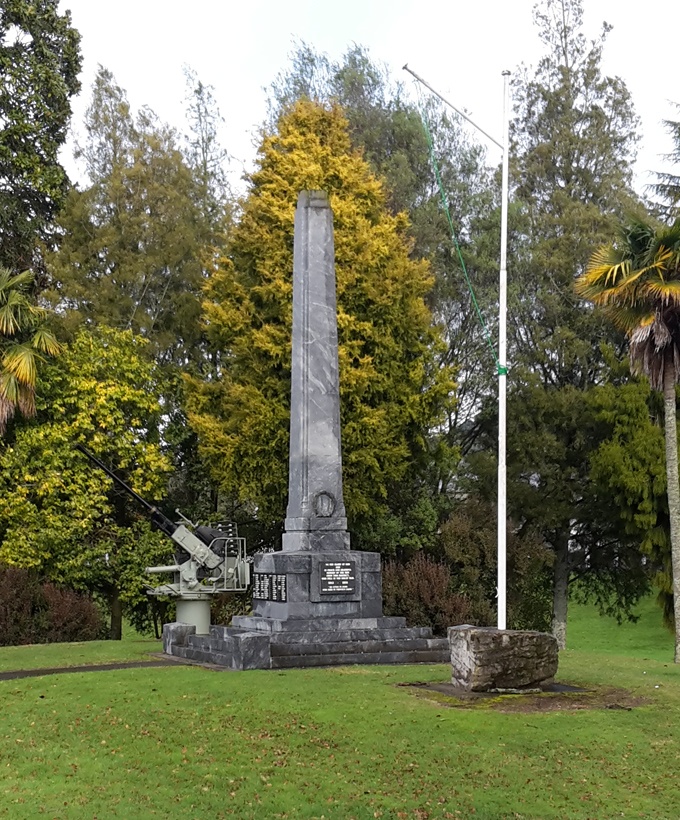Te Kūiti First World War Memorial
What do you know?
Could you let me know if James Gray or Arthur Gray names are on the Te Kuiti war memorial
See Rootsweb message board for info. re. A. D. Lissaman of Te Kuiti War Memorial.
I have been told that the name my Great Uncle 2nd Lieut. Clifford Barclay who died at the landing on Gallipoli on 25 April 1915 appears on the Te Kuiti War Memorial. Is this true?
Clifford was a son of Dr Herbert Barclay of Waimate (later Lieut Col. in the Royal Medical Corps.)
Clifford Barclay was born in Waimate, edcated Christs College and worked as a stock agent for a Timaru firm - I think Guiness Le Cren. He may have been transferred to Te Kuiti, but otherwise I can find no reason why his name may be on the Te Kuiti Memorial. He was a member of the Canterbury Regiment - 6/404.
O I missed that he was killed at Le Quesnoy, France. Famous action.
Lt Col Curly Blyth retired to Cambridge and usd to go to the St Andrews Church with the e Quesnoy stained glass window. This is a detail of the war memorial window in St Andrew's Church, Cambridge, New Zealand. The image shows New Zealand soldiers scaling the walls at Le Quesnoy. The caption reads 'Le Quesnoy 4 Nov 1918'.
The French Garden
At St Andrews Anglican Church, Cambridge
The French Garden was unveiled and dedicated in the grounds of St Andrews Church, Cambridge, on the 11th of June 2006. They had been created in the preceding weeks, as was the traditional style covered lich-gate, on the Victoria Street side of the churchyard.
The garden marks the links between the church itself and Cambridge as a whole with the country of France. Within the formal box hedges ar shrubs and white standard roses there were three plaques. These mark links to France in World War One, World War two and modern times.
The World War One connection is the plaque in memorial to the late Lieutenant Colonel Lawrence 'Curly' Blyth, who had been the last surviving member of the New Zealand Division during the Battle of Le Quesnoy. He passed away in 2001, and during the ceremony on the unveiling of the garden in 2006 his ashes were buried beneath the plaque.
The World War Two connection is a plaque unveiled by Cambridge born John Morris who dedicated this memorial to Maurice and Lucienne Vouzelaud, who were members of the French Resistence that saved John following his having to bail out of a Lancaster bomber over occupied France.
And the modern connection is a plaque celebrating the twinning of the towns of Cambridge and Le Quesnoy.
http://www.cambridgelequesnoy.co.nz/French_Garden.html
http://www.nzhistory.net.nz/media/photo/le-quesnoy-memorial-window
Just a week before the end of the First World War in November 1918, the New Zealand Division captured the French town of Le Quesnoy. It was the New Zealanders' last major action in the war. To this day, the town of Le Quesnoy continues to mark the important role that New Zealand played in its history. Streets are named after New Zealand places, there is a New Zealand memorial and a primary school bears the name of a New Zealand soldier. Visiting New Zealanders are sure to receive a warm welcome from the locals.
The Germans held Le Quesnoy for almost the entire war, from August 1914 through to its dramatic liberation on 4 November 1918. The New Zealanders scaled the ladders they set against the ancient walls of the town and took the remaining Germans as prisoners.
http://www.nzhistory.net.nz/war/le-quesnoy/new-zealand-and-le-quesnoy
He's listed at the Auckland Museum, if you have a photo of him send a electronic copy to the Auckland Museum and they will add it to his record.
http://muse.aucklandmuseum dot com
RANK LAST HELD
Rifleman
FORENAME(S)
Walter Henry
SURNAME
Buck
WAR
World War I, 1914-1918
SERIAL NO.
42030
FIRST KNOWN RANK
Rifleman
OCCUPATION BEFORE ENLISTMENT
Labourer
NEXT OF KIN
Mrs Mary Ann Buck (mother), 10 Paddy's Lane, Cannock, Staffordshire, England
BODY ON EMBARKATION
New Zealand Rifle Brigade
EMBARKATION UNIT
Reinforcements H Company
EMBARKATION DATE
14 March 1917
PLACE OF EMBARKATION
Wellington, New Zealand
TRANSPORT
HMNZT 79
VESSEL
Ruapehu
DESTINATION
Devonport, England
NOMINAL ROLL NUMBER
57
PAGE ON NOMINAL ROLL
32
LAST UNIT SERVED
New Zealand Rifle Brigade, 1st Battalion
PLACE OF DEATH
Le Quesnoy, France
DATE OF DEATH
4 November 1918
AGE AT DEATH
34
YEAR OF DEATH
1918
CAUSE OF DEATH
Killed in action
My great uncle Walter H Buck was killed in the WW1 whilst in action in France in 1918. He moved to Te Kuiti from England in 1909 and joint the NZRB. I was interested to know if his name is listed on the Te Kuiti War memorial? Can Any one help?







Community contributions